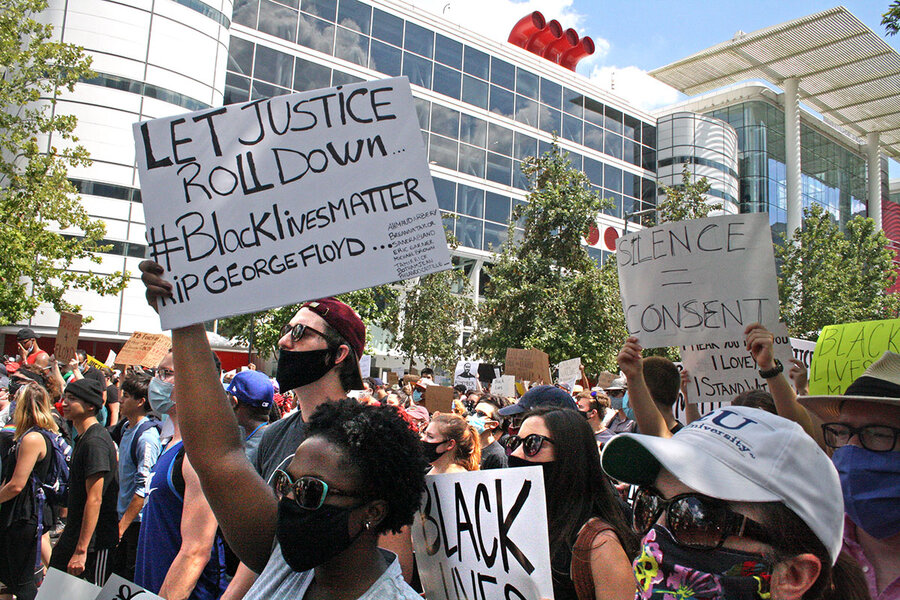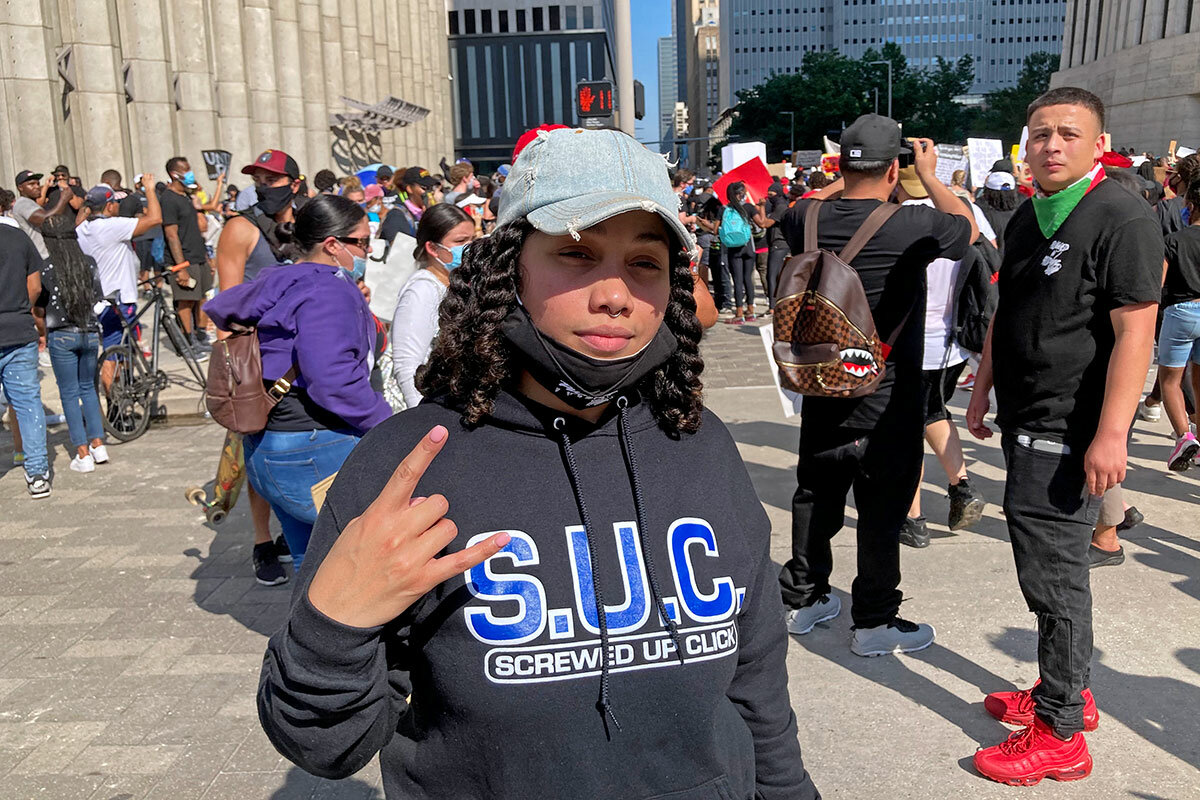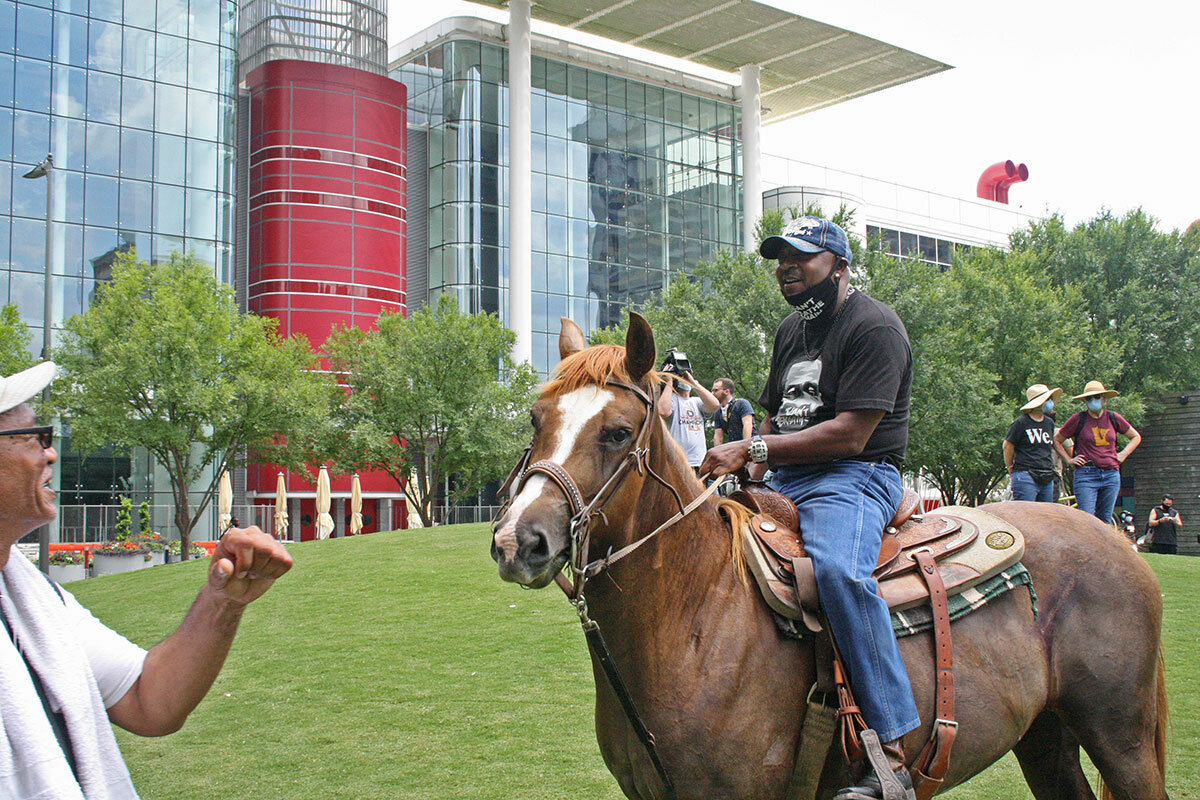‘He woke the world up.’ Houston’s Third Ward remembers George Floyd.
| Houston
Have we been here before?
The civil unrest seen across the United States since a Minneapolis police officer killed George Floyd may be rivaled only by the chaotic summers of the late 1960s, when racial tensions, the civil rights movement, and the Vietnam War fueled widespread protests and rioting.
Houston – and the Third Ward, the historically black neighborhood where Mr. Floyd grew up – experienced that late ’60s unrest, including a violent encounter in 1967 on the campus of Texas Southern University (TSU), a historically black college in the Third Ward, that saw police arrest almost 500 students and shoot up a dormitory.
Why We Wrote This
As George Floyd is laid to rest in Houston Tuesday, residents of Houston’s Third Ward – where Mr. Floyd grew up – reflected on his life and the national crisis of conscience sparked by his death.
Race riots broke out in cities around the country in those months – a period now known as the “long, hot summer of 1967.” In a report analyzing the cause of the unrest, the Kerner Commission concluded that white Americans were largely to blame for maintaining systemic inequality between black and white Americans.
President Lyndon Johnson didn’t act on those conclusions, and a year later protests again erupted across the country – again, including Houston – after the assassination of the Rev. Martin Luther King Jr.
“Because before it was only one community, [authorities could] ignore it,” says Ronald Goodwin, a history professor at Prairie View A&M University, of earlier protests by the black community. “Now you can’t ignore it.”
Houston, which hosted a memorial service for Mr. Floyd Monday, has seen daily protests demanding justice for his death. Yet the civil unrest of this moment is different, locals and experts say, in ways that represent not just social progress, but a broader disillusionment with American institutions that could be an even tougher problem to tackle than what the country faced 50 years ago.
“While we should be focused on police brutality in black communities, what this has brought out is a broad discontent in society. And that’s something we need to be concerned about and take seriously,” says Marcus Casey, an economist at the University of Illinois, Chicago, and the Brookings Institution.
Adding to the urgency of today’s response, over the past five years police have killed about 1,000 Americans every year. That number has not changed despite promises of reform after the massive riots and protests resulting from high-profile deaths of African Americans including Michael Brown, Eric Garner, Sandra Bland, Philando Castile, and Freddie Gray.
In the Third Ward, Brother Deloyd T. Parker Jr., who runs a local community center and knew Mr. Floyd, has been protesting police brutality for decades. But this time, he acknowledges, is different.
“I’m very hurt about what happened to George,” he says, “but I’m hurt every time. There’s a George every day.”
“What happened to George was the straw that broke the camel’s back. What that uncovered and unveiled is a lot of injustices that have taken place all over the country, and all over the world,” he adds. “He’s pretty much a symbol now.”
“Everybody is here”
When 60,000 people demonstrated here last week, one thing stood out to many Houstonians in the crowd: the diversity of the people around them.
“You see Asians, you see whites, you see Latinos, you see Indians, Native Americans. Everybody is here,” said Ephesian Fields, a black woman, during the protest.
“Things may change,” she added, but “at the end of the day, all we need is hope. All we have is hope. And the protests show hope.”
The need for the protests was bluntly apparent to many protesters.
“Anybody with the skin color that ain’t white, we get treated [expletive],” said Eduardo Reyes, sporting a Mexican flag bandana around his neck.
His girlfriend, Kazaree Barnett, was wearing an S.U.C. pullover, the name of the rap group Mr. Floyd belonged to. Through tears she said the objective was to march in peace.
“It could be my dad, it could my brother, it could be a loved one, or it could be me,” she added. “At the end of the day none of us are safe. We just want to be safe.”
That diversity is perhaps not surprising for Houston, a majority-minority city. But the nationwide protests over Mr. Floyd’s killing have been diverse in another way: geography.
In Texas, major cities have seen protests, but so have small towns with small black populations. Demonstrators have gathered in downtown New York City, Chicago, and Los Angeles, but also in those cities’ suburbs. Protesters have turned out in majority-white cities like Salt Lake City, Utah, and Des Moines, Iowa.
The cellphone video that captured Mr. Floyd’s last moments – Minneapolis police officer Derek Chauvin kneeling on his neck for nearly nine minutes while he begged for breath – is visceral and horrifying, even compared to other videos of police killings. (Mr. Chauvin has been charged with second-degree murder; the three other officers who participated in detaining Mr. Floyd face charges of aiding and abetting his killing.)
And to be sure, racism, police brutality, and the Black Lives Matter movement are the banner issues for protesters. But in this moment of heightened disillusionment there are a host of other issues driving people onto the streets.
The financial and psychological shock of the COVID-19 pandemic is certainly a factor, whether it be for Gen Zers entering the job market or Millennials still recovering from the Great Recession. (The pandemic has hit Houston’s large oil and gas industry especially hard.)
But more than half the country also disapproves of President Donald Trump’s performance. Half of Americans believe that Supreme Court justices don’t set aside personal or political views when they make rulings, and have “very little” confidence in Congress. Even more Americans are increasingly concerned that issues like the threat of white nationalism and climate change aren’t getting enough attention.
“There’s a growing pessimism about the institutions in the United States, the elites,” says Professor Casey. “That’s what’s driving broader participation.”
People of all races “feel this growing inequality in society, the idea that institutions aren’t very responsive to the rank and file,” he adds. “They see those things as linked to the police brutality.”
The Tre
For decades, police brutality has rarely not been top of mind in the Third Ward.
In 1967, protests broke out in Houston after a child drowned in the Holmes Road dump, a landfill in a black community. As protests continued and tensions climbed, Houston police raided the TSU campus on the early morning of May 17, firing around 3,000 rounds into Lanier Dormitory and arresting 488 students. Only five students were eventually charged, and they were all exonerated.
While much of the late ’60s unrest was racially diverse – the civil rights movement in particular – the riots of the “long, hot summer” were characterized by events like that at TSU: unrest sparked by local grievances in black communities over issues like police brutality and poor living conditions.
This moment is different, and in many ways the Third Ward is different too. When Mr. Floyd was growing up there, Mr. Parker says, the neighborhood – known as “the Tre” – had just begun to change.
“It was blacker,” he adds. “You wouldn’t see many people of European extraction walking their dogs down the street.”
Mr. Floyd spent time at S.H.A.P.E. Community Center, which Mr. Parker co-founded in 1969. He attended Jack Yates High School – named after one of the area’s early Baptist pastors – and, having shot up to 6 feet 6 inches tall, stood out in football and basketball, helping the school get to the state championship in 1992.
After dropping out of college, he returned to the Third Ward and helped establish the city’s renowned hip-hop scene. After getting into trouble with the law and spending four years in prison, he returned to the Third Ward with a new dedication to improving his community. He would often stop by the S.H.A.P.E. Center and talk to kids.
“He’d always come with a positive attitude, a positive disposition,” Mr. Parker recalls. “He wasn’t content with who he was, he wanted to be better.”
“He was on the move to doing that,” he adds, “but he was robbed of doing that.”
Diversity and solidarity?
Last week, as the march was finishing a few miles away, the finishing touches were being put on a mural tucked onto a side street in one of the Third Ward’s most neglected housing projects. It’s become a landmark for those who want to pay their respects to Mr. Floyd, and a beacon for people who live there.
“He woke the world up,” said Leonard McGowen, a resident of the Cuney Homes projects and a close friend of Mr. Floyd.
Mr. Floyd left Houston for Minneapolis around 2014, seeking a fresh start. The Third Ward, meanwhile, had been rapidly gentrifying. With black residents moving to suburbs and whites and Latinos moving in, the neighborhood’s black population dropped from 79% in 2000 to 67% in 2015. The worry is that it could follow the same path as the Fourth Ward, a historic neighborhood created by freed slaves.
“Fourth Ward is oldest black community in Houston. It’s not there no more. It’s nothing but town homes,” says John “Bunchy” Crear, a former Black Panther Party member who has lived in the Third Ward for decades.
For some black Houstonians marching in protests, they feel just as threatened by gentrification as they do the police – and by the pandemic, which has disproportionately harmed African Americans. One thing that hasn’t changed since the ’60s: the wealth gap between black families and white families. The average white household in 2016 had the same median wealth as 11.5 black households combined.
“They’re pushing us blacks out so they can gentrify Third Ward and pretty much erase our history,” Ms. Fields said during last week’s protest. “That’s just one more way of them trying to enslave us and not let us have anything.”
Not everyone in the Third Ward believes this change is wholly negative. Many admit that it is, to a degree, inevitable – the neighborhood used to be mostly Jewish, until after World War II – and community groups have been working to prevent “unchecked” gentrification in favor of something more equitable.
“We can’t stop people moving in, that’s a lost battle, but we want to make sure we’re as much in control of this community as we need to be,” says Mr. Parker. “Change is imminent, we know that. But let that change be positive change.”
More integration in American society seems to have bred solidarity in the George Floyd protests, says Professor Casey. With more diversity in schools and neighborhoods, and with social media, African American worldviews are more broadly understood than in the 1960s.
“There’s more overlapping spheres. So something that affected a black man in Minnesota might matter to a white person in Arizona,” he says. “Along with seeing the institutional issues, it feels much more personal across the country.”
Looking at protests over Mr. Floyd’s death around the world, Mr. Parker thinks it’s even bigger than that.
“This is a global movement,” he says.
And how would Mr. Floyd feel if he could see this now?
“He’d be excited that black people and people of conscience, and people who love freedom are standing up,” says Mr. Parker. “I can see him smiling right now.”







